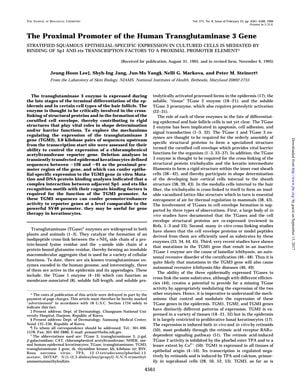TLDR The TGM3 gene's promoter region is key for skin and hair cell function and may aid gene therapy.
The study investigated the regulation of the transglutaminase 3 gene (TGM3), which is important for the late stages of epidermal differentiation and hair follicle cell function. Researchers analyzed 3.0 kilobase pairs upstream of the TGM3 transcription start site and identified the proximal promoter region between −126 and −91. This region was found to confer epithelial-specific expression in epidermal keratinocytes. The study revealed that the interaction between Sp1- and ets-like recognition motifs is crucial for TGM3 promoter function. The findings suggested that these sequences could be useful for gene therapy in keratinocytes due to their strong promoter/enhancer activity.
161 citations
,
June 1993 in “Journal of Biological Chemistry” Trichohyalin helps in hair and skin cell structure and function by binding calcium and linking proteins.
118 citations
,
June 1993 in “Journal of Biological Chemistry” Human and mouse TGase3 enzymes are similar but differ near the activation site, crucial for their function in skin and hair development.
72 citations
,
May 1993 in “The Journal of Cell Biology” Trichohyalin in sheep hair follicles may help with structure and calcium binding.
116 citations
,
April 1986 in “The journal of cell biology/The Journal of cell biology” Trichohyalin is a protein in hair follicles that helps form hair filaments.
138 citations
,
December 1976 in “Journal of Biological Chemistry” The enzyme from human skin can cross-link proteins and needs calcium to work.
103 citations
,
February 1972 in “Proceedings of the National Academy of Sciences” A unique enzyme in guinea pig hair follicles helps form protein cross-links in hair.
22 citations
,
August 2020 in “Cells” TGM3 is important for skin and hair structure and may help diagnose cancer.
 5 citations
,
December 2021 in “Frontiers in Cell and Developmental Biology”
5 citations
,
December 2021 in “Frontiers in Cell and Developmental Biology” Enzymes called PADIs play a key role in hair growth and loss.
9 citations
,
August 2021 in “International journal of molecular sciences” PPARγ is essential for maintaining healthy skin, controlling inflammation, and ensuring proper skin barrier function.
 March 2025 in “International Journal of Molecular Sciences”
March 2025 in “International Journal of Molecular Sciences” Free long-chain fatty acids can stimulate hair growth in mice.
65 citations
,
March 2017 in “Experimental Dermatology” Curly hair is influenced by specific genetic variations.


